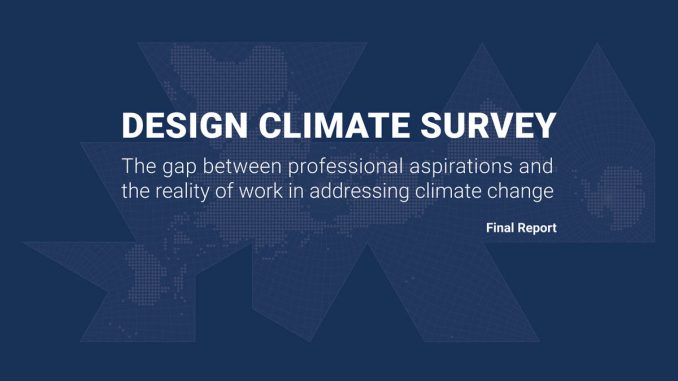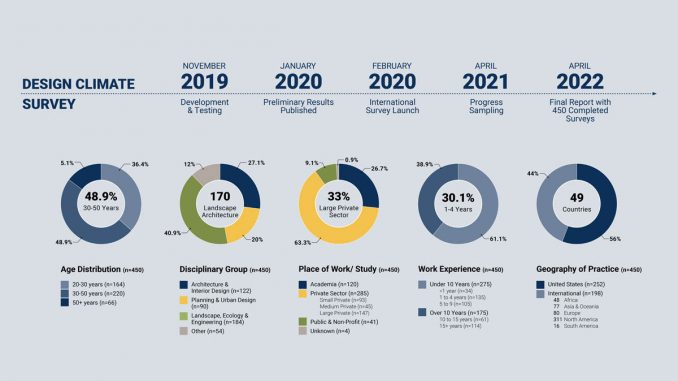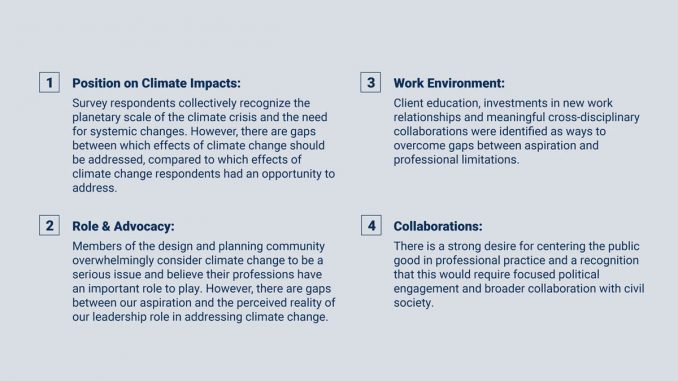Article By: Justin Kollar, Thomas Nideroest and Sourav Kumar Biswas

The International Landscape Collaborative (ILC) developed the Design Climate Survey to shed light on how design and planning professionals feel about their work and the global concerns of climate change. The survey sought to understand how planning and design professionals across the U.S. and the world perceive their role in addressing the threats of climate change and how they aspire to build an environmentally just future. This report highlights the findings of the Design Climate Survey. The report found professional gaps between aspiration and reality of a wide array of planning and design professionals from across the US and worldwide.
Anxiety about the impacts of climate change should awaken us to the need for reflection and change, hoping that this is simply a stepping stone towards broader and more frank dialogue in which our collective anxiety can be turned into collective action.
Methodology
From Spring 2020 to Fall 2021 responses were collected from a total of 450 respondents across various age groups, fields, places of work, ranges of experience, and places around the world. Little substantial difference was found across age groups, years of experience, and whether respondents were based in or outside the U.S.

Key Takeaways
After more than a year of collecting data, the final survey results establish a foundation upon which the design and planning professions might examine their collective aspirations in the climate fight. These aspirations fell into four buckets: exploring new practice models, expanding their value proposition to new clients, cultivating meaningful collaborations, and ensuring their field has a seat at the table with decision-makers to take action.

Discussion: Considering a Course of Action
To bridge the gap between aspiration and reality requires our professionals to tread unfamiliar practices and processes, from political advocacy to truly multidisciplinary collaborations to designing multi-scalar strategies and policies. We must ask ourselves: what types of conversations and collaborations will fulfill our aspirations for meaningful impact on issues we find most urgent? Here are four areas for consideration.
1. To meaningfully address climate change we must scale our work outward and upward
To make systemic changes, we should ask: how do we develop opportunities and collaborations that have a more comprehensive impact on the urban and infrastructure systems at the local, regional, and planetary scale?
Scaling our work upward is about impacting urban and infrastructure systems at the local, regional, and planetary scales in the urban sphere. We should also look to engage more directly with existing policymaking and financing initiatives. Multidisciplinary collaborations with a wide range of experts and working with municipalities toward risk-sensitive land-use planning and building codes can inform new approaches to urbanization and conservation.
On the other hand, scaling outward is an opportunity to address other systems that make up the most significant land masses, like forests and agriculture. In this context, scaling outward is about expanding our work beyond the city environment, requiring different relationships. Scaling outward will also require practitioners to reflect on their disciplinary expertise and modes of communication. Design and planning strategies may need constant re-framing to ensure that ways of speaking and engaging are grounded in how people experience their everyday life and prospective risks.
2. To embolden our leadership role, we must seek agency beyond our professional boundaries and instill this ethic in the next generation
The climate leadership (and generational) gap is closely tied to how we can expand our relationship with clients in areas where design and planning expertise is already valued. Concrete examples could include helping clients consider upstream relationships and better visualizing holistic sustainability approaches’ benefits and financial reinvestments.
Leadership on climate change must also be driven by the next generation of emerging planning and design professionals. Millennials in particular do not have the kinds of wealth-building opportunities as previous generations—Baby Boomers and Gen X—yet have more at stake in a climate-changed future. This gap is even more striking when considering the amount of loans many students in planning and design take are saddled with after graduation. Can young professionals focus on publicly-oriented leadership or address broader issues when salaries do not reflect the generational disparities in student debt? Adapting academic syllabi to engage with timely topics and multi-disciplinary exchange, rather than pursuing siloed education models, is one way to allow students to view adaptation as a professional necessity.
3. To overcome our professional limitations, it is imperative to invest in new work relationships and meaningful collaborations
Increasing collaboration and addressing industry limitations will be critical for design and planning professionals to be more effective in addressing the complex challenges of climate change. The survey made clear that many respondents hope to engage and collaborate with a broader array of organizations and fields, though to do so, we must aim to overcome real and perceived limitations in our work.
Disinterested clients, limited budgets, and structural limitations in the industry are all difficult things to overcome. There is also a dearth of work addressing climate change in the public sector—even if much of the most meaningful work in addressing climate change may be located there. While private-sector projects do address the effects of climate change, much of it is still driven by the profit motive. Unfortunately, extreme concentrations of wealth go hand in hand with policies that advocate a market-driven approach to climate solutions and less on deriving funds for major public investments from wealth-based taxes. Likewise, land speculation is still a crucial part of many resilience-driven project models, which take advantage of the cash-strapped nature of small municipalities and their hunger for property tax revenues.
4. We should place more emphasis on the public good and engagement in the civic realm
While projects in the public sector more often prioritize the public good and broader notions of equity, there are barriers to working in the public sector tied to simplistic assumptions of what role the government can or should play. Instead, we should view the public sector as a vehicle — something that can (and should) be reshaped by a new generation. Programs that aim to promote public service work in the design and planning professions can support desires to work for the public good and build critical experience in the short term. In the long-term, a general economic and cultural shift is still needed to place a value on public service so that private sector salaries no longer appear as the only option for indebted students.
To read the entire report, click here.
Would you like to explore the data yourself? We made the data publicly available on an interactive web-chart. Follow this link to launch your queries and explore where you might invest in helping to address climate change head on collectively. For more information and inquiries for raw data, please contact the International Landscape Collaborative (ILC).
The Gap Between Aspiration and Reality: How Designers and Planners See Their Role in Addressing Climate Change
Article By: Justin Kollar, Thomas Nideroest and Sourav Kumar Biswas
Image Credits: Courtesy of International Landscape Collaborative (ILC)
